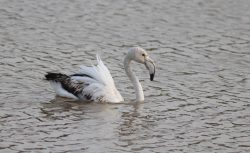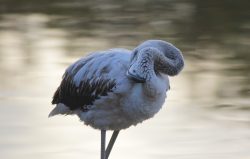The injured bird phone rings. The voice on the other side of the phone says we should go to Mellieħa immediately because a flamingo is injured. This is certainly not a usual call so we jump in the car and head straight to the White Tower Bay in the north of the island. When we arrive, there is no sign of the flamingo and we are told the bird had been collected by a member of the public. Thankfully, after a making a concerned call to the police, the young bird was recovered and taken to the vet for a much needed check over.
Upon examination, the vet noticed a small injury on the beak and two missing primary feathers from the right wing, down to mishandling during its ordeal. Unfortunately, the loss of primary feathers prevents the ability to fly. Located furthest away from the body, birds usually have between 9-11 primary feathers; flamingos on the other hand have 12! Primary feathers are the longest and narrowest of the feathers and are essential for providing the bird with the initial thrust needed to lift up from the ground. They also have the ability to rotate so that they decrease air resistance and help the bird fly. Luckily, with the correct diet and care, these feathers can grow back in time, meaning this young bird was the perfect candidate for rehabilitation!
 Flamingos are very unlike any other bird we handle at BirdLife Malta; their feet are very delicate, meaning that after rescuing the bird and transferring it to our rehabilitation centre, a member of our team needed to assist the flamingo in standing. This helps to increase circulation to the legs that is absent while the bird is restricted in movement during transit. Unlike falcon species that are our common “patients”, flamingos don’t get used to being captive. Having a bird like this in captivity means that you observe behaviours that indicate stress, like pacing up and down the enclosure, as well as alarm calling when seeing the carer. With other birds that we are rehabilitating, close contact is sometimes not necessary and we always make sure to keep it to a minimum. However, with the flamingo we had to monitor it closely every day!
Flamingos are very unlike any other bird we handle at BirdLife Malta; their feet are very delicate, meaning that after rescuing the bird and transferring it to our rehabilitation centre, a member of our team needed to assist the flamingo in standing. This helps to increase circulation to the legs that is absent while the bird is restricted in movement during transit. Unlike falcon species that are our common “patients”, flamingos don’t get used to being captive. Having a bird like this in captivity means that you observe behaviours that indicate stress, like pacing up and down the enclosure, as well as alarm calling when seeing the carer. With other birds that we are rehabilitating, close contact is sometimes not necessary and we always make sure to keep it to a minimum. However, with the flamingo we had to monitor it closely every day!
Not only that, but flamingos require a very specific diet of algae, shrimp, clams, crustaceans, and molluscs – a special mix that is not easy to come by. To make sure our newest patient received the perfect daily meals, we prepared a delicious crustacean and shrimp puree twice a day using a hand blender – yum! All of this food then needed to be placed in a large, deep tray so the flamingo could step in and start its characteristic feeding behaviour, walking or stamping its feet while its bill is in the water in order to disturb its “prey” !
!
With the support of the vet, our conservation team worked round-the-clock to provide this specialist care. After three very busy weeks, the determined young bird was deemed fit for release and on the 19th September 2017 was taken to the Għadira Nature Reserve where it could enjoy its new found freedom.
With primary feathers usually taking around 10-12 weeks to grow back, it would be at least another few weeks until this juvenile could fly again. Flamingos are highly social animals, sometimes gathering in groups of thousands, so being alone has definitely been a challenging experience for the bird! From time to time during migration, other flamingos paid him a visit before continuing on their mammoth journey, yet despite being young, this plucky bird was not prepared to give up! Yearning to join its pink-feathered friends, it kept flapping its big beautiful wings and running up and down the islands at the reserve in preparation to take to the skies. Of course, this also required refuelling with a lot of food and of course getting  some beauty sleep. Now, its efforts have eventually paid off as it is showing signs of leaving the comfort and familiarities of the reserve back to a life in the wild very soon.
some beauty sleep. Now, its efforts have eventually paid off as it is showing signs of leaving the comfort and familiarities of the reserve back to a life in the wild very soon.
It is only with our member’s constant support and encouragement that makes work like this possible! If you want to help us make a difference and support our rehabilitation work, why not join the BirdLife Malta community as a member or simply donate to make success stories like this one happen more often – thank you!
By Antaia Christou, Fundraising Officer at BirdLife Malta
Photos by Aron Tanti
